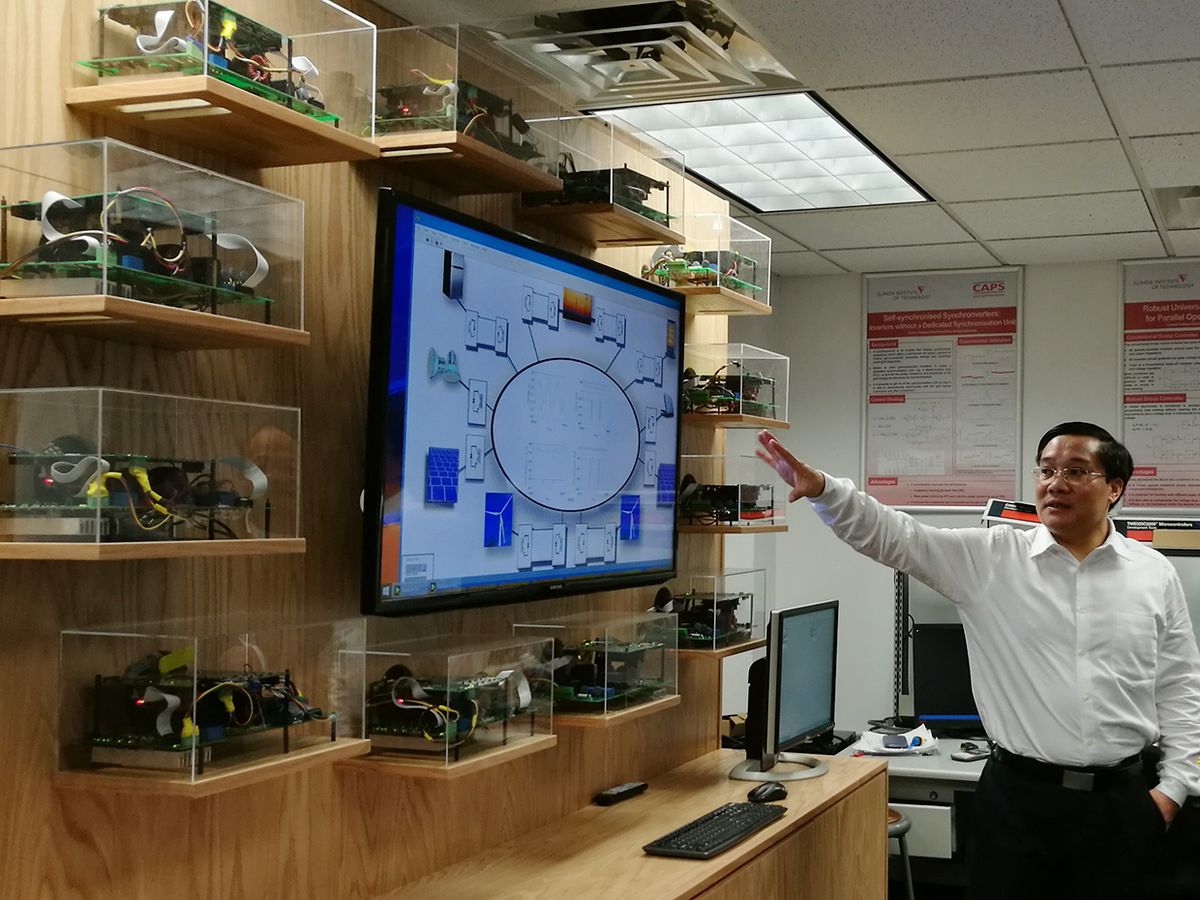When Qing-Chang Zhong, IEEE Fellow and a professor of energy and power engineering at the Illinois Institute of Technology, thinks of the words “democracy” and "harmony,” he envisions the future of the electric power grid.
To Zhong, the concept of who or what may generate electric power is in flux. The 20th century model of a monopoly utility that owns a uni-directional connection to a customer is vanishing. In its place is the 21st century paradigm that millions of users and their devices can consume or generate electricity as needed, democratizing the power grid.
Further, in Zhong’s view, these devices either can wreak havoc through asynchronous and random interactions with the grid and one another, or can work together to support a more robust and secure power system.
Zhong credits his Chinese heritage and its 5,000 years of cultural history for shaping his view of grid stability.
“The most important thing in Chinese culture is to have harmony,” the 47-year-old Zhong says, taking cues from the Chinese classic philosophical text Tao Te Ching. Mindful of the democratic concepts of the rule of law and equal treatment under the law, Zhong set out more than 15 years ago to discover what, if any, common trait might exist to make a smartphone and a nuclear power plant work in harmony for grid stability.
His research showed that the inherent synchronous nature of large power plants was essential to the grid’s existence. To the detriment of harmony, however, generating equipment like wind turbines and solar arrays don’t work the same way.
“The speed of the wind changes all the time,” Zhong says, and can sometimes act as “misbehaving resources.” Zhong realized that a key device in machines like wind turbines and solar panels (which generate power in DC that must be converted to AC for the grid) is the power electronic converter.
He reasoned that if a mathematical model could be written and software built, then it would be possible to program the converter to act like a virtual synchronous machine, or VSM. As a VSM, it would operate in harmony with the rest of the power generation fleet.
But that’s only the supply side of the system. Zhong turned his attention to electric loads like washing machines, electric vehicles, and smartphones and argued that if those devices also could be synchronized, then both the supply and the demand sides of the electric power system would be in harmony. As with wind turbines and solar panels, power electronic converters were the common denominator.
In his architecture, known as “SYNchronized” and “DEMocratized” (or SYNDEM), Zhong says that modifying the converter on, say, a computer’s electric plug or an electric motor’s speed drive would cause them to behave like a virtual synchronized machine.
To explain how SYNDEM might work, he points to the 28 September 2016 South Australia blackout. Around 650,000 electric customers lost service when a severe storm led to a cascading transmission network failure as multiple wind farms tripped offline within a matter of minutes.
In its inquiry into the outage, the Australian Energy Market Operator found software settings in the wind farms prevented repeated restarts as rapid voltage or frequency events occurred. One group of wind turbines able to accept as many as nine “ride-throughs” over a 120-second period stayed online. But a second, larger group of turbines that was unable to accept as many ride-throughs tripped. Their loss triggered an overload and shutdown of the interconnector.
Had Zhong’s power system been in place, all power electronics-based players—on the supply side, inside the network, as well as on the demand side—would have been able to actively regulate grid stability.
In the Australian blackout, for example, when a wind turbine tripped off, all synchronous and virtual synchronous machines would have responded to the drop and boosted power output to balance the shortfall. At the same time, VSM-enabled devices on the demand side would have autonomously decreased their power consumption to balance the shortage. Not only would the drop have been reduced, but the number of loads that tripped offline would likely have been smaller.
As a side benefit, Zhong’s architecture enhances grid security because the machines interact directly through the power network and not the communications network.
“The smart grid has some benefits, but poses security problems,” Zhong says. “You don’t want someone to turn solar panels into an attacker.”
To commercialize his concept, Zhong has created a Chicago-based company known as SYNDEM. A related effort is under way to incorporate virtual synchronous machine concepts into relevant IEEE standards.
And Zhong says that the SYNDEM approach is slated to be introduced first to energy storage, wind, and solar applications before moving to the load side of the equation.
“All players still will be different” and, as in a democracy, each will have its own “opinion,” he says. But those players also would be synchronized in a way that achieves harmony and works toward a common goal: system stability.
Contributing Editor David Wagman has been covering energy issues for three decades, focusing on all forms of electric power generation, regulation, and business models. He is particularly interested in the ongoing electrification of advanced economies and the effects that distributed generating resources could have on efforts to decarbonize national grids. Wagman, who is based in Colorado, is currently editorial director for IEEE Engineering 360, a search engine and information resource for the engineering, industrial, and technical communities.



